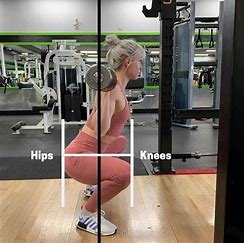
Proper Hip Alignment During Squats: The Key to Safe and Powerful Lifting
Squats are a powerhouse lower-body exercise, but they’re only effective—and safe—if your hip alignment is on point. When your hips are properly aligned, the movement becomes more balanced, controlled, and powerful. Poor hip positioning, on the other hand, can lead to injury, muscle imbalances, and even limit your strength gains over time.
1. Why Hip Alignment Matters in Squats
The hips are the foundation of the squat. Every part of the movement—from the descent to the drive upward—relies on them being in the right position.
- Even Weight Distribution: Proper hip alignment ensures that your bodyweight (and any added weight) is evenly shared between both sides of your body, reducing the risk of overloading one hip, knee, or ankle.
- Joint Protection: Misaligned hips can cause your knees to cave inward (valgus collapse) or your lower back to overextend, leading to strain or injury in the lumbar spine, knees, or SI joints.
- Efficient Movement Mechanics: Good alignment helps you move more naturally and powerfully through your full range of motion, making each rep more effective.
- Muscle Activation: Aligned hips allow the correct muscles—glutes, hamstrings, quads, and core—to engage properly and share the workload. If your hips are off, certain muscles will dominate while others stay underactive.
2. Common Hip Alignment Mistakes
- Knee Valgus (Knees Caving In): Often caused by weak glutes or tight hips. Can lead to knee and hip injuries.
- Pelvic Tilt (Over-arching or Rounding the Back): An anterior (forward) pelvic tilt over-activates the lower back, while a posterior (tucked) tilt can round the spine—both increasing injury risk.
- Uneven Hips: Sometimes due to muscle imbalances or leg length differences, this causes one side to work harder than the other.
- Toes Too Far In or Out: This can throw off the natural tracking of the hips and knees during the squat.
3. How to Check and Improve Hip Alignment
- Neutral Spine and Pelvis: Before you even squat, engage your core and tilt your pelvis slightly so your spine is in a natural, neutral position—not overly arched or tucked.
- Knees Over Toes: As you squat down, your knees should track in line with your toes—not caving inward or flaring too far out.
- Hinge From the Hips First: Begin the movement by pushing your hips back slightly, then bending the knees. This ensures you’re using the hips to lead—not just collapsing downward.
- Even Pressure Through the Feet: Keep your weight distributed between the heels, midfoot, and balls of your feet (“tripod foot”) to help the hips stay balanced.
- Use a Mirror or Record Yourself: Watching your squat form from the front and side can help you identify asymmetries or misalignments.
4. Exercises to Improve Hip Alignment and Control
- Hip Mobility Drills (90/90 stretches, hip openers, pigeon pose): Improve range of motion so hips can move freely.
- Glute Activation (glute bridges, clamshells, banded walks): Helps stabilize the hips and prevent knee collapse.
- Core Strengthening (dead bugs, planks, bird dogs): A strong core supports the pelvis and spine during squats.
- Single-Leg Work (split squats, step-ups, lunges): Helps correct muscle imbalances and improve hip control.
Summary
Proper hip alignment during squats isn’t just about avoiding injury—it’s about unlocking your full strength potential. When your hips are aligned, your entire body moves more efficiently, you activate the right muscles, and you set the stage for long-term progress in your training. It’s one of those “small adjustments” that makes a huge difference.
